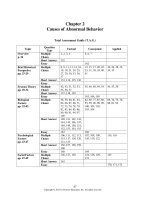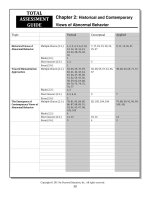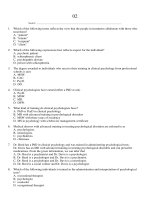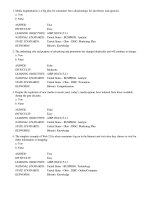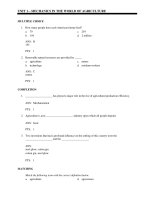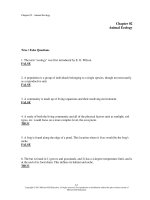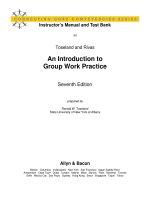Cognitive psychology 7th edition solso test bank
Bạn đang xem bản rút gọn của tài liệu. Xem và tải ngay bản đầy đủ của tài liệu tại đây (79.56 KB, 19 trang )
Chapter 2 Cognitive Neuroscience
Multiple Choice Questions
1 ) "Mind" in the context of cognitive psychology is:
A) a PDP system
B) the actions that occur within the brain
C) the same as the brain
D) the mental aspect of the soul
E) nonexistent
Answer: B
Page Ref: 35
2 ) How is MEG different from other neurological sensing techniques?
A) MEG provides the most accurate resolution of nerve cell activity
B) MEG is much less expensive to use
C) MEG is much more expensive to use
D) MEG is very simple to use
E) MEG is no different from the other techniques
Answer: A
Page Ref: 53
3 ) The areas of the brain related to functions such as sensory feelings, motor function, and vision
are:
A) constantly changing
B) generally agreed upon by scientists
C) unable to be accurately studied
D) irrelevant to cognitive neuroscience
E) subject to personal opinion
Answer: B
Page Ref: 36
4 ) Transcranial magnetic stimulation (TMS) is used with EEG or MEG to:
A) evaluate whether the EEG or MEG worked
B) simulate strokes to see their effects
C) evaluate cortical activity
D) simulate realistic problem solving experiences
E) evaluate the effects of changes in brain activity on perceiving and thinking
Answer: E
Page Ref: 38
100
5 ) Cognitive neuroscience originated in the 1970s by:
A) Michael Gazzaniga
B) George Miller
C) James Watson
D) Endel Tulving
E) William James
Answer: A
Page Ref: 35
6 ) The basic building blocks of the central nervous system (CNS) are:
A) neutrons
B) protons
C) neurons
D) electrons
E) phonemes
Answer: C
Page Ref: 38
7 ) Cognitive neuroscience is defined as:
A) the science that combines imaging technology and cognition
B) a discipline that combines cognitive psychology and neuroscience
C) a new science that involves neurology and neuropathology
D) the study of neurons, their function, and morphology
E) the study of neutrons and cognitive psychology
Answer: B
Page Ref: 36
8 ) The reasons psychologists use information from the neurosciences include:
A) the need to find physical evidence for theories of the mind
B) the development of techniques (e.g., CAT scans) which allows for a better look at the brain
C) the need to find correlates between brain pathology and behavior
D) the work of computer scientists who are attempting to simulate human cognition
E) all of the above
Answer: E
Page Ref: 37
101
9 ) A perceptron is:
A) the smallest unit of a neuron
B) a noninvasive scanning technique
C) neural net architectures
D) a chess playing computer
E) a microchip used for artificial vision
Answer: C
Page Ref: 38
10 ) Techniques that allow scientists to peer into the human brain include:
A) PET
B) CAT
C) MRI
D) EEG
E) all of the above
Answer: E
Page Ref: 38
11 ) The central nervous system (CNS) consists of:
A) the brain and eyes
B) the cerebellum and Broca's Area
C) the spinal cord and brain
D) the cerebellum and the brain stem
E) the corpus callosum and the brain stem
Answer: C
Page Ref: 38
12 ) The earliest writings of the brain may be traced to:
A) the Middle Ages
B) the ancient Greeks
C) the ancient Egyptians
D) the ancient Polynesians
E) the Han Dynasty of China
Answer: C
Page Ref: 39
102
13 ) Some estimates of the number of neurons in the human brain place the number at more than:
A) 100,000
B) 10 million
C) 1 billion
D) 100 billion
E) 1 trillion
Answer: D
Page Ref: 40
14 ) Each cubic inch of the human cortex contains:
A) about 100 yards of nerve fibers
B) about 10 miles of nerve fibers
C) about 10 meters of nerve fibers
D) about 100 miles of nerve fibers
E) about 10,000 miles of nerve fibers
Answer: E
Page Ref: 38
15 ) There are ________ different types of neurons.
A) 3
B) 7
C) about 100
D) about 1000
E) about 10,000
Answer: D
Page Ref: 40
16 ) Which of the following is not a region of the neuron?
A) the receptor
B) the axon
C) the dendrites
D) presynaptic terminals
E) all of the above are regions of a neuron
Answer: A
Page Ref: 40
103
17 ) The ________ gather(s) neural impulses from other neurons.
A) dendrites
B) synapses
C) the myelin sheath
D) neurotransmitters
E) axon
Answer: A
Page Ref: 40
18 ) An axon is:
A) part of a neuron
B) a long tubular transmitting pathway
C) a carrier of neural signals
D) sometimes wrapped in a myelin sheath
E) all of the above
Answer: E
Page Ref: 40
19 ) The junctures between neurons are called:
A) myelin sheath
B) terminal buttons
C) axons
D) synapses
E) nodes
Answer: D
Page Ref: 40
20 ) The fatty substance surrounding large axons is called:
A) the myelin sheath
B) terminal buttons
C) axons
D) synapses
E) the ranvier sheath
Answer: A
Page Ref: 40
104
21 ) How many different chemical substances are known or suspected to function as
neurotransmitters?
A) 6
B) 16
C) 26
D) 46
E) 60
Answer: E
Page Ref: 40
22 ) At the synapse neurotransmission is achieved by means of:
A) a direct physical link between neurons
B) a chemical neurotransmitter which changes the polarity of the receiving dendrite
C) a change in the organic composition of the axon
D) a partial reduction of the carbon 12 between neurons
E) electrical signals which arc across the synapse
Answer: B
Page Ref: 40
23 ) What Egyptologist identified the hieroglyphic character for the brain?
A) Edwin Smith
B) Donald Hebb
C) James Breasted
D) Pierre Flourens
E) King Tut
Answer: C
Page Ref: 60
24 ) Neuronal firing can be measured using:
A) transitory potentials
B) event-related potential recordings
C) chromic electrode implants
D) impulse monitors
E) they cannot be measured accurately
Answer: B
Page Ref: 41
105
25 ) Two general classes of neurotransmitters have been identified. They are:
A) inhibitory and excitatory types
B) emotional and non-.emotional types
C) organic and inorganic types
D) Alpha and Beta types
E) active and inert types
Answer: A
Page Ref: 42
26 ) The speed of neurotransmission along the axon is:
A) a good measure of human intelligence
B) related to the size of the neuron
C) slow for large neurons and fast for small neurons
D) unmeasurable
E) related to the strength the impulse
Answer: B
Page Ref: 42
27 ) A parallel processing model of brain functioning allows for:
A) limbic intervention
B) processing of higher order information and sensory information at the same time
C) the simultaneous processing of information in both hemispheres
D) alternative pathways to be used if part of the pathways are destroyed
E) all of the above
Answer: D
Page Ref: 40
28 ) If part of the pathways in the brain are destroyed:
A) the system breaks down
B) alternative pathways take over some functions
C) motor functions break down, but speech is usually spared
D) vision is usually the first attribute to show a deficit
E) they are usually able to grow back
Answer: B
Page Ref: 41
106
29 ) Knowledge is thought to:
A) be localized to a single neuron
B) be spread over clusters of neurons
C) be distributed throughout the brain
D) involve tens of thousands of neurons in the parietal lobe
E) exist independent of the brain
Answer: C
Page Ref: 42
30 ) Phrenologists believed that bumps on the head represented areas pertaining to:
A) personal character, aptitude, and emotions
B) tumors
C) memory loss
D) advanced brain activity
E) an individual's astrological sign
Answer: A
Page Ref: 43
31 ) The idea of "localization" as applied to the brain suggests that:
A) the brain operates like a government bureau
B) blood flow is concentrated in a few places when thinking takes place
C) some functions (e.g., language processing) are associated with specific areas
D) all of the above
E) none of the above
Answer: C
Page Ref: 44
32 ) The current view of the localization vs. holistic theory of the brain is that:
A) the brain is divided into well-defined areas which carry out specific functions
B) no single function is isolated
C) some mental attributes are localized but many functions are distributed
D) it is presently impossible to make an intelligent conclusion as there are vast individual
differences in the way brains function
E) none of the above
Answer: C
Page Ref: 44
107
33 ) The cerebral cortex is:
A) divided into two hemispheres
B) about 1.5 to 5 millimeters thick
C) gray
D) in the forebrain
E) all of the above
Answer: E
Page Ref: 45
34 ) The ________ helps to give the brain a "walnut" appearance.
A) sulci
B) gyri
C) fissures
D) folds
E) all of the above
Answer: E
Page Ref: 45
35 ) The surface of the brain (if spread out) would measure about:
A) 324 square inches
B) 745 square inches
C) 1032 square inches
D) 5690 square inches
E) 10,000 square inches
Answer: A
Page Ref: 45
36 ) The motor side of the left hemisphere controls:
A) movements on the left side of the body
B) movements on the right side of the body
C) movements for the entire body
D) hand and arm movements on the right side and leg and feet movements on the left side of
the body
E) movements below the waist
Answer: B
Page Ref: 46
108
37 ) When we say that "information is processed in the brain contralaterally" we mean that:
A) sensory information from one side of the body is initially processed by the opposite
cerebral hemisphere
B) left-handed people process sensory information in the opposite cerebral hemisphere that
right-handed people do
C) one hemisphere processes one type of information; the other, another type of information
D) sensory information is processed in one hemisphere, and motor information is processed
in the other hemisphere
E) all of the above
Answer: A
Page Ref: 46
38 ) The four major lobes of each cerebral hemisphere are:
A) frontal, posterior, anterior, and occipital
B) temporal, frontal, anterior, and somasthetic
C) parietal, language, motor, and occipital
D) sensory, motor, visual, and associative
E) frontal, temporal, parietal, and occipital
Answer: E
Page Ref: 46
39 ) In humans, the motor cortex:
A) is located below the visual cortex
B) is not ipsilateral
C) is divided equally in all areas devoted to motor sensory activities
D) has more area devoted to hand movement
E) has less area devoted to tongue movement
Answer: D
Page Ref: 46
40 ) Wernicke's area of the brain seems to involve:
A) language production
B) imagery
C) thinking and problem solving
D) language comprehension
E) control of fine motor movements
Answer: D
Page Ref: 48
109
41 ) One of the earliest scientists to recognize that some brain functions operated in parallel was:
A) Wernicke
B) Broca
C) Newell
D) McClelland
E) Lashley
Answer: A
Page Ref: 47
42 ) Support for the notion that the nervous system is made up of discrete elements, or neurons,
was found by:
A) Lashley
B) Solso & Short
C) Newell & Simon
D) Ramon y Cajal
E) Wernicke & Broca
Answer: D
Page Ref: 48
43 ) By studying the behavior of rats, Karl Lashley discovered that learning was:
A) confined to only a few, well-defined neurons
B) highly dependent on emotions
C) not confined to specific neurons
D) a function of the number of times a rat ran down a maze and the magnitude of the reward
E) independent of the quality of the reward
Answer: C
Page Ref: 49
44 ) The theory of mass action holds that:
A) memories seem to be distributed throughout the brain
B) learning is confined to a local region of the brain
C) learning is more effective if done in groups
D) learning and memory are subject to variations in blood flow
E) memories are located in clusters based on their associations with other memories
Answer: A
Page Ref: 50
110
45 ) According to Lashley the brain operates:
A) independently from the spine
B) in a compartmentalized manner
C) sequentially
D) faster than some computers
E) holistically
Answer: E
Page Ref: 50
46 ) Damage to the brain:
A) always leads to a decrease in abilities
B) leads to a decrease of abilities in the case of motor performance
C) is always devastating to speech if in the left hemisphere
D) does not always lead to a diminution of functions
E) is always more handicapping when it occurs at an early age
Answer: D
Page Ref: 50
47 ) It is now possible with MRI and fMRI, to capture images in as little as:
A) 30 milliseconds
B) 30 seconds
C) 60 milliseconds
D) 60 seconds
E) 3 minutes
Answer: A
Page Ref: 52
48 ) What questions can MEG answer?
A) How big is each part of the brain?
B) What color is the brain?
C) Why was the use of a CT scan ineffective?
D) Which part of the brain undertakes different tasks?
E) How evolved is the brain?
Answer: D
Page Ref: 53
111
49 ) Electroencephalograph (EEG) records electrical signals from the brain via electrodes placed on
the:
A) wrists
B) ear lobes
C) neck
D) scalp
E) face
Answer: D
Page Ref: 52
50 ) CAT scans:
A) are similar to PET scans in that they both use radioactive particles introduced into the
blood stream
B) emit less x-rays than PET scans
C) are another term for PET scans
D) are different from PET scans because CAT scans use x-rays
E) none of the above
Answer: D
Page Ref: 53
51 ) The four stages in conducting an experiment using PET scans (Peterson et al., 1988) includes all
but:
A) a resting stage
B) the appearance of a word on a screen
C) the reading of the word by the research participant
D) the spelling of the word
E) the production of each word
Answer: D
Page Ref: 54
52 ) PET scans of experienced computer game players shows that their brains:
A) use less energy than a novice
B) use more energy than a novice
C) use about the same amount of energy as a novice
D) use less energy in the left hemisphere than a novice
E) use more energy than a novice in certain areas, but about the same in others
Answer: A
Page Ref: 55
112
53 ) MANSCAN is a:
A) faster version of a PET scan
B) system of imagining using x-ray transmission
C) gender-analysis computer program
D) device used in conjunction with MRI
E) company that makes Scantrons
Answer: D
Page Ref: 52
54 ) The corpus callosum:
A) connects the right and left hemispheres
B) is a massive bundle of nerves
C) is sometimes cut to reduce the symptoms of epilepsy
D) if cut, "traps" information on either side of the hemispheres
E) all of the above
Answer: E
Page Ref: 61
55 ) Commissurotomized patients were studied by:
A) Karl Lashley
B) Steven Petersen
C) Paul Broca
D) Rumelhart and McClelland
E) Roger Sperry
Answer: E
Page Ref: 62
56 ) Studies on commissurotomized patients indicate that the left side of the brain is involved in all
but which of the following cognitive process:
A) language
B) conceptualization
C) spatial tasks
D) analysis
E) classification
Answer: C
Page Ref: 62
113
57 ) Studies on commissurotomized patients indicate that the right side of the brain is involved in:
A) spelling
B) face recognition
C) performing mathematics
D) speech analysis
E) all of the above
Answer: B
Page Ref: 62
58 ) Visual information connected to the right hemisphere is received from ________.
A) the right side of the retina
B) the left side of the retina
C) right side of the right eye and the left side of the left eye
D) both sides of the retina
E) none of the above
Answer: A
Page Ref: 62
59 ) Which of the following is NOT true of chimeric faces?
A) they are always recognized as female when flashed at high speeds
B) they are half man and half woman
C) they are used in lateralization studies
D) they are used in studies with split-brain patients
E) they are used to reveal the independence of the two hemispheres
Answer: A
Page Ref: 64
60 ) According to Corballis (1989):
A) humans evolved right-handedness in the use of tools
B) humans evolved left-hemisphere mechanisms for language
C) language use began 2 to 3 millions years ago
D) the evolution of hemisphere specialization may be associated with the ability to create
new associations
E) all of the above
Answer: E
Page Ref: 65
114
61 ) The left hemisphere is primarily responsible for:
A) language and verbal processing
B) music and nonverbal memory
C) tactile recognition
D) spatial processing
E) face processing
Answer: A
Page Ref: 67
62 ) The right hemisphere is primarily responsible for:
A) complex, voluntary movement
B) language and verbal processing
C) spatial processing
D) verbal memory
E) surrealistic art
Answer: C
Page Ref: 67
63 ) The cerebellum is involved with:
A) basic life support functions such as heart rate, breathing and blood pressure
B) control of motivation and emotional processes
C) speech production and speech comprehension
D) planning and coordination of complex motor skills
E) eating behavior
Answer: D
Page Ref: 45
64 ) Within the hindbrain, basic life support functions such as heart rate, breathing, and blood
pressure are associated with:
A) the cerebellum
B) the medulla
C) the reticular formation
D) the hippocampus
E) the thalamus
Answer: B
Page Ref: 53
115
65 ) The thalamus:
A) relays sensory information to the cerebral cortex
B) plays an important role in the regulation of eating, drinking, and sexual behavior
C) has been linked to a variety of motivational and emotional behaviors
D) is thought to be critically involved in the formation of memories
E) controls the limbic system
Answer: A
Page Ref: 45
66 ) The pituitary gland is:
A) relays information between the cerebral cortex and the cerebellum
B) the master gland of the endocrine system
C) controls thinking and sensing
D) regulates temperature
E) coordinates muscle movement
Answer: B
Page Ref: 45
Essay Questions
1 ) Trace the history of the mind/body issue. Cite both philosophic and physiological sources.
Answer: œ Physical world
œ Mental world
œ Distinction between mind and body is obvious but so is their interaction
œ Mind-things done by the brain
œ Physical world ¬ laws and objects ¬ brain ¬ body
œ Psychological world ¬ laws and thoughts ¬ cognition ¬ mind
Page Ref: 39
2 ) How have recent discoveries in brain sciences helped cognitive psychology understand more
about the human mind?
Answer: œ Development of sophisticated equipment
œ Increased understanding of brain pathology and effects on behavior
œ Neural network approaches
Page Ref: 38
3 ) Identify and discuss neurophysiological monitoring techniques.
Answer: œ PET
œ CAT
œ MRI
œ EEG
Page Ref: 38
116
4 ) Sketch and label the neuron.
Answer: œ See figure in book
Page Ref: 39
5 ) Recount the development of the localization of the brain to the concept of mass action. Be sure
to identify the principle characters in this debate.
Answer: œ Some functions are localized to specific areas of the brain
œ Phrenologists claimed to locate many attributes to certain areas of the head/brain
œ Pierre Flourens thought this was nonsense and studied the effects of surgery on
behavior
œ Motor and sensory functions are not localized to specific regions-but also distributed
œ Higher-order cognitive processes are distributed throughout the brain
Page Ref: 44
6 ) Discuss the "two hemispheresπtwo functions" proposition. What support has been gathered in
this area?
Answer: œ Called contralaterality
œ Tumors and excision in one hemisphere or the other produced different effects on
behavior
œ Severed corpus callosum demonstrated functional asymmetry
œ Split brain researchπRoger Sperry
œ Visual field, optic chiasm, opposite hemisphere
œ Cognitive studies with intact subjects-use of chimeric faces
œ See table in book for a summary of left and right hemisphere functions
Page Ref: 61
7 ) How does cognitive psychology fit into the investigation of the brain?
Answer: œ Efforts to understand the human mind better
œ Aids in models of human information processing
œ Knowledge of brain structures and functioning (i.e., neural networks) aids in cognitive
psychology's model building
Page Ref: 35
8 ) What ecological advantage would exist for the division of the retinal image into separate visual
fields and separate cerebral hemispheres?
Answer: œ Laterality developed 2-3 million years ago and set the stage for the development of
more complex functions
œ Corballis-evolution of hemisphere specialization may be associated with flexibility of
thought
Page Ref: 65
9 ) Given the results of Haier's PET study of game playing, how can the consumption of oxygen
and blood in the brain still be used as an indicator of cognitive processes?
Answer: œ Learning seems to be a function of greater efficiency not greater effort
Page Ref: 57
117
10 ) Many lateralization studies select right-handed males. Why would this be so? Should a
psychology of hemispherical specialization be based on right-handed males?
Answer: œ Males tend to show more clear distinctions of lateralization and thus are easier to
study
œ Various opinions will be expressed regarding whether the research should be solely
based on right-handed males
Page Ref: 60
118
